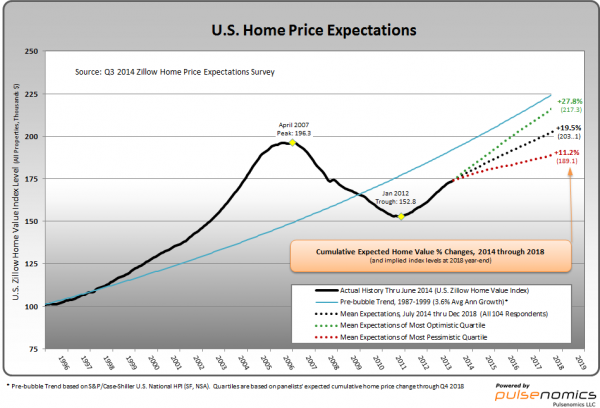On August 1, 2014, the Zillow Q3 2014 Home Price Expectations Survey results were released. This survey is done on a quarterly basis.
Two excerpts from the Press Release:
The panel also said they expect U.S. median home values to end 2014 up 4.6 percent, on average, and to exceed their 2007 peak levels by the end of 2017, roughly a decade after the housing bust and ensuing recession began. The survey of 104 economists, real estate experts and investment and market strategists asked panelists to predict the path of the U.S. Zillow Home Value Index through 2018, and solicited opinions on the age of homeowners, the homeownership rate and the impact of rising mortgage interest rates on home sales volume. The survey was sponsored by leading real estate information marketplace Zillow, Inc. and is conducted quarterly by Pulsenomics LLC.
also:
Panelists predicted the U.S. Zillow Home Value Indexiv would rise 4.6 percent year-over-year by the end of 2014, to $177,895, and expected the pace to slow in each of the next four years. The most optimistic groupv of panelists predicted a 5.6 percent annual increase in home values this year, on average, while the most pessimisticvi predicted an average increase of 3.7 percent.
Various Q3 2014 Zillow Home Price Expectations Survey charts are available, including that seen below:
As one can see from the above chart, the average expectation is that the residential real estate market, as depicted by the U.S. Zillow Home Value Index, will continually climb.
The detail of the Q3 2014 Home Price Expectations Survey (pdf) is interesting. Of the 104 survey respondents, only one (of the displayed responses) forecasts a cumulative price decrease through 2018; and even that one does not foresee a double-digit percentage cumulative price drop. That forecast is from Mark Hanson’s prediction, which foresees a 4.35% cumulative price decrease through 2018.
The Median Cumulative Home Price Appreciation for years 2014-2018 is seen as 4.70%, 8.99%, 12.48%, 15.85%, and 19.33%, respectively.
For a variety of reasons, I continue to believe that even the most “bearish” of these forecasts (as seen in Mark Hanson’s above-referenced forecast) will prove too optimistic in hindsight. From a longer-term historical perspective, such a decline is very mild in light of the wild excesses that occurred over the “bubble” years.
I have written extensively about the residential real estate situation. For a variety of reasons, it is exceedingly complex. While many people continue to have an optimistic view regarding future residential real estate prices, in my opinion such a view is unsupported on an “all things considered” basis. Furthermore, (even) from these price levels there exists outsized potential for a price decline of severe magnitude, unfortunately. I discussed this downside, based upon historical price activity, in the October 24, 2010 post titled “What’s Ahead For The Housing Market – A Look At The Charts.”
_____
The Special Note summarizes my overall thoughts about our economic situation
SPX at 1925.15 as this post is written

No comments:
Post a Comment